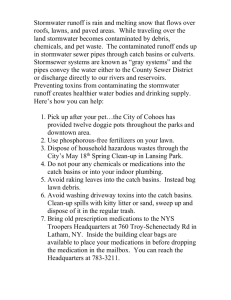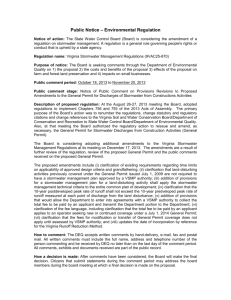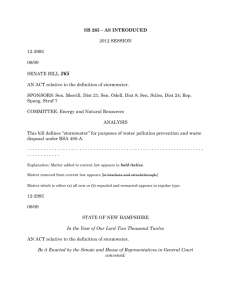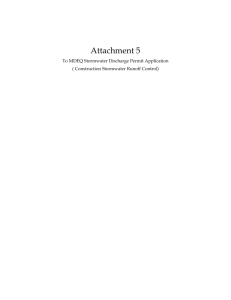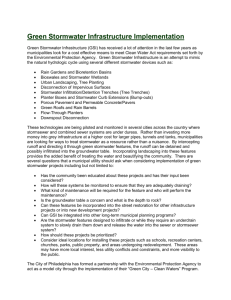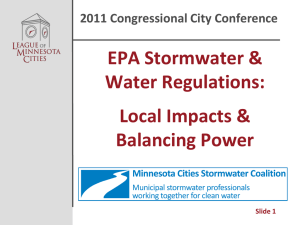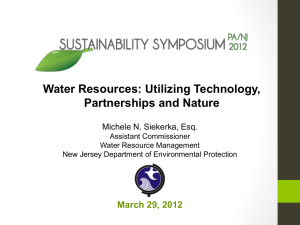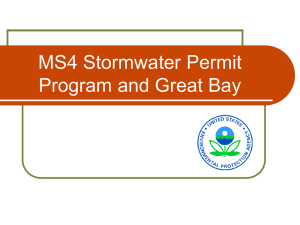Final Rule - Application of Pesticides to Waters of the United States
advertisement
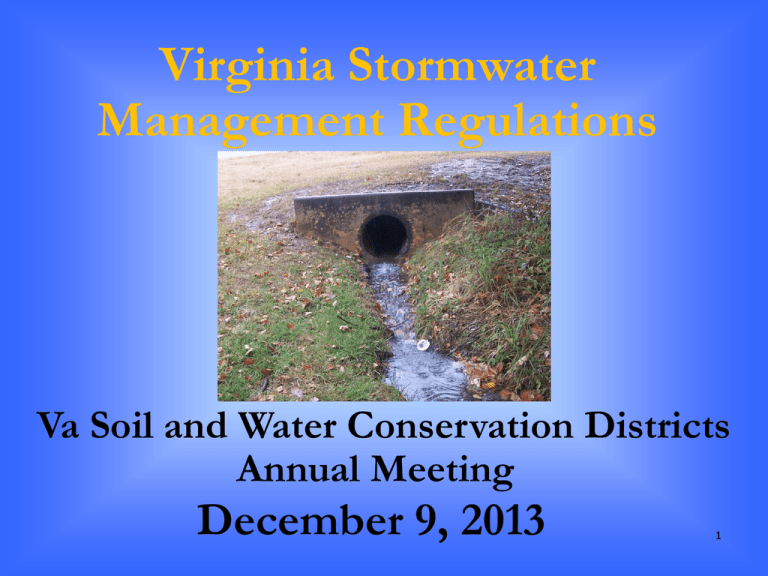
Virginia Stormwater Management Regulations Va Soil and Water Conservation Districts Annual Meeting December 9, 2013 1 STORMWATER REGS IN VA Clean Water Act/NPDES • • • Industrial SW GP Construction SW GP MS4: Phase I Ind., Phase II GP State Regulatory Programs • • • Va SW Management Permit Statewide Erosion and Sediment Control Statewide Chesapeake Bay Preservation Tidewater What is an MS4? "Municipal separate storm sewer" means a conveyance or system of conveyances otherwise known as a municipal separate storm sewer system, including roads with drainage systems, municipal streets, catch basins, curbs, gutters, ditches, manmade channels, or storm drains: 1.Owned or operated by a federal, state, city, town, county, district, association, or other public body, created by or pursuant to state law, having jurisdiction or delegated authority for erosion and sediment control and stormwater management, or a designated and approved management agency under §208 of the CWA that discharges to surface waters; 2. Designed or used for collecting or conveying stormwater; 3. That is not a combined sewer; and 4. That is not part of a publicly owned treatment works. MS4 Regulatory Update Municipal Separate Storm Sewer System • • Maximum Extent Practicable Program Evolution: 5 year permit cycle Phase II MS4 GP – July 1, 2013 MS4 Phase Is • • • • • • Arlington-June 2013 Prince William Chesterfield Henrico Fairfax Hampton Roads Virginia’s Urbanized Areas Blacksburg Bristol Charlottesville Fredericksburg Harrisonburg Kingsport (TN) Lynchburg Richmond Roanoke Virginia Beach Washington, D.C Winchester 6 Minimum Control Measures Public education and outreach on stormwater impacts Public involvement and participation Illicit discharge detection and elimination Construction site stormwater runoff control Post-construction stormwater management in new development and redevelopment Pollution prevention/good housekeeping for municipal operations GP Measurable Goals MCM 1: 3 High Priority WQ Issues MCM 2: 4 Local Activities MCM 3: Mapping; Dry Weather Field Screening: <50 all annually; >50 at least 50 annually MCM 4, 5: ELGs, Local VSMP Programs MCM 6: Biennial Training Special Conditions 2014 VSMP Regulation Changes New Construction GP Water Quality Criteria Water Quantity Criteria Local Programs Construction GP Reissuance • Regulatory Process • • • SWCB Proposed Permit February 26, 2013 State Water Control Board as Final Dec 17 Current Permit Expires July 1, 2014 Primary Issues • Federal Requirements Common Plan of Development Specificity of ELGs –buffers, etc. Address TMDL WLA • Cross Jurisdictional Issues • Simplification Stormwater Criteria Address Land Use Changes as a Result of Development Pre-development – non-regulated land use Land Disturbance Activity regulated under federal regulation Post-development – non-regulated land use The water quality and quantity design criteria are implemented in conjunction with the VSMP General Permit for Stormwater Discharges from Construction Activities. These criteria are based on a State regulation separate from federal requirements. Basis for 0.41 lbs/ac/yr P Threshold Statewide requirement based on three types of land cover and NRCS hydrologic soil groups of soil on site Threshold assumes 10% impervious cover, 30% turf, 60% forest The Impervious Cover Model focuses on protecting water quality in local streams. Current Methodology “Traditional” BMP pollutant removal efficiencies do not take into account the removal that occurs when the runoff volume is reduced. Many BMPs do not reduce runoff volume at all. Runoff Reduction Method Using BMPs that also provide volume reduction provides greater overall pollutant (mass load) removal This reflects a “Mass Balance” Approach New Design Criteria Environmental Site Design There is no longer a specified “Average land cover condition” (% Imp. Cover or Poll. Load) below which you are not required to meet any water quality requirements “Site” is redefined Imagine the site as an area that you can put construction fencing around ,but including undisturbed areas that are going to be protected as part of the plan. Water Quantity Criteria Past approaches in urban stormwater hydrology focused on Peak Flow Flooding Velocity The new paradigm is Volume-Based Hydrology (VBH) The Energy Balance Method The longer and stronger the force acts, the more sediment is moved. The ENERGY BALANCE METHOD is based on the interaction of both flow volume and peak discharge, which determine the stream channel configuration Local SW Program Adoption VSMP currently State run by DEQ • • • • Plan Review Time/Construction Delays State vs Local Confusion Streamline SW Programs/One Stop Shop Compliance = Water Quality & Flood Control Local Programs • • • • Local Control/Issues Local Water Quality Localized Flooding Developing Now VSMP Local Programs Effective September 13, 2011 Implementation Date July 1, 2014 • State Assistance Efforts SLGAC Regional Outreach, Surveys Tool Kit, Guidance Model Ordinance RFPs VSMP Training Plan Phased Training Train the Trainer Regional Training Certification Program– Basic Class Plan Reviewer Inspector Program Administrator Dual Coordination is Key RR Methodology SWM Handbook BMP Clearinghouse Summary of Change MS4s • • Measurable Goals Special Conditions New Construction GP • • ELGs Simplification Local Programs New Water Quality and Water Quantity Criteria and Methodologies DEQ Question and Answer Ginny Snead, PE The Louis Berger Group gsnead@louisberger.com
